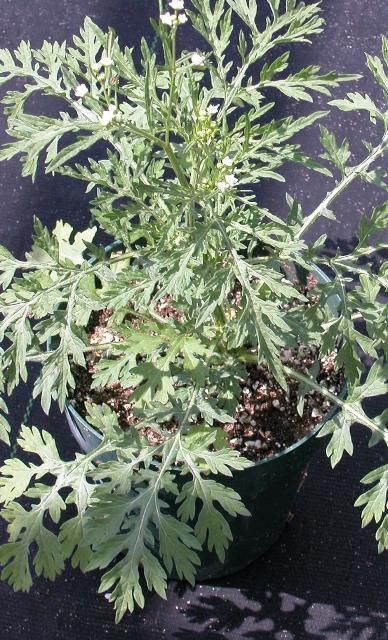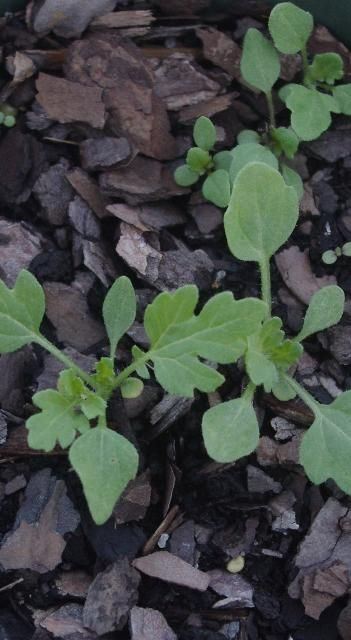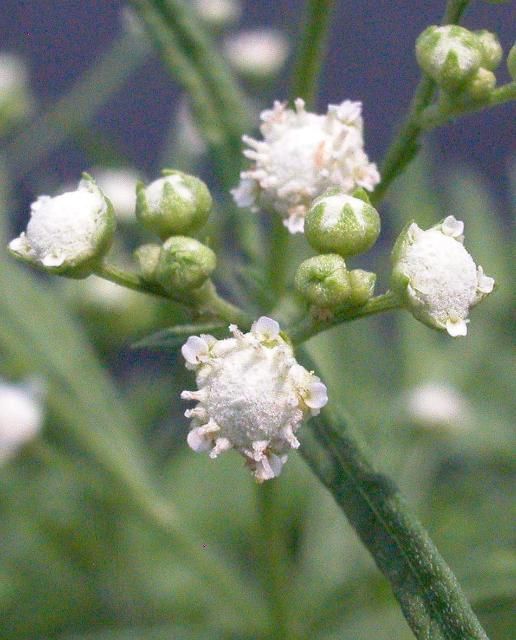Species Description
Class: Dicotyledonous plant
Family: Asteraceae
Other Common Names: False ragweed, Ragweed parthenium, Santa Maria feverfew, Santa-Maria, Whitetop weed, Famine weed, and Congress weed
Life Span: Long-lived annual herb
Habitat: Occurs in semi-arid, subtropical, tropical, and warmer temperate regions. It is found on roadsides, along railways, pastures, grasslands, seasonal flood plains, open woodlands, riparian zones (banks of water courses), waste areas, disturbed sites, lawns, gardens, and multiple crops. It is particularly aggressive in disturbed and degraded pastures in semi-arid environments. In Florida nurseries, it is commonly found in non-crop areas, ditch banks, and in any area in which the soil has been disturbed.
Distribution: Ragweed parthenium is thought to have originated from the area surrounding the Gulf of Mexico and is native to Central and South America (Rollins 1950). Since the 1970s, it has spread extensively and rapidly in many parts of the world (Evans 1997).
Growth Habit: Erect (upright), much-branched herbaceous plant that forms a basal rosette of leaves during the juvenile phase (Figure 1). It usually grows 1.5 to 4.2 feet tall but can occasionally reach up to 6 feet or more in height.

Credit: Annette Chandler, UF/IFAS
Seedling: Rosette basal leaves; pinnatifid (lobes on the leaf blade less than half way down toward the midrib) to bipinnatifid (doubly pinnatifid); pubescence (hairy) on stems and leaves (Figure 2).

Credit: Annette Chandler, UF/IFAS
Shoot: Stems are erect, commonly 11 to 40 inches tall, hirsute (hairy), octangular (eight angles or edges), and grooved, with panicle-like branching, longitudinally striate. Leaves are simple, alternate, 1 to 7 inches long, 0.5 to 4 inches wide, whitish green, becoming smaller towards the top of the branches. The surfaces of the leaves and the stems are covered with white trichomes (hairs) (Kaur et al. 2014).
Roots: Fibrous roots develop from a deep taproot system that can extend up to 6 feet in length (Kaur et al. 2014).
Inflorescence: A loose terminal panicle, 3–5 mm in diameter, with several pentagonal and hemispherical heads (capitula) that are slightly convex on top, and short slender pedicels 3–20 mm long, densely pubescent. Disk florets are whitish in color and 3–5 mm wide (Figure 3).

Credit: Annette Chandler, UF/IFAS
Fruit and Seeds: Five small achenes (dry, one seeded fruit) are usually produced in each flower head. These achenes are =2.0 mm long, obovate, and black. Four to five black wedge-shaped seeds are produced by each flower and are 2 mm long with very thin white scales. Each plant can produce up to 25,000 seeds (Kaur et al. 2014). Seeds are dispersed mainly by water currents, animals, the movement of vehicles, contamination in stock feed, grains, and on machinery, and to a lesser extent by wind.
Similar Species: Ragweed parthenium is very similar in appearance to Ambrosia psilostachya (perennial ragweed), Ambrosia artemisiifolia (common ragweed), Ambrosia confertifolora (burr ragweed), and Ambrosia tenuifolia (lacy ragweed) during the vegetative stage of growth. The distinguishing characters of Parthenium hysterophorus from all these species is that it has ribbed stems and white flower heads during the flowering stage.
Plant Biology: Ragweed parthenium is most common in the southern part of Florida (USDA-NRCS 2013) but can be found throughout the state and in other southern US states. It reproduces only by seeds. Viability of seed is 85% or higher (Navie et al. 1998). Buried seeds can remain viable for 8–10 years and have been found to persist longer than seeds on the soil surface (Bulletin OEPP/EPPO bulletin 2014). In tropical and subtropical climates, at almost any time of the year, seeds can germinate if the required soil moisture is available (Parson and Cuthbertson 1992). Flowering occurs 4–8 weeks after germination and it continues until drought or frost kills the plant (Bulletin OEPP/EPPO bulletin 2014). Two to three life cycles can be completed each year under favorable conditions in warm climates (Fatimah and Ahmad 2009).
Management
Cultural and Physical Control
Cultural control involves prevention of weed seed introduction by using proper sanitation practices by using clean liners/nursery stock, growing medium, and equipment (Stamps 2011). Handweeding and hoeing can be done before the plant produces seeds but is labor intensive if a large area is infested (Goodall et al. 2010; Tadesse et al. 2010; Tamado and Milberg 2004). Plowing and rototilling are effective methods for controlling emerged plants but will not control germinating seeds. Mowing the plants can help temporarily, but ragweed parthenium quickly regenerates itself, matures, and produces more seeds (Muniyappa et al. 1980). Use of both organic and inorganic mulches can help in controlling ragweed parthenium in nurseries and landscapes by preventing seeds from germinating.
Chemical Control
Preemergence Control
Areas heavily infested with ragweed parthenium will likely contain large amounts of seeds in the soil. Because these seeds remain viable for several years, multiple preemergence herbicide applications will be needed for long-term control (Butler 1984; Navie et al. 1998; Tamado et al. 2002). Preemergence herbicides including flumioxazin (Broadstar™, SureGuard®), oxadiazon (Ronstar®), dimethenamid-P (Tower®), indaziflam (Marengo®), pendimethalin + dimethenamid-P (FreeHand®),trifluralin + isoxaben (Snapshot®), oxyfluorfen + oryzalin (Rout®), oxyfluorfen + pendimethalin (OH2®), oxyfluorfen + prodiamine (Biathlon®), and oxyfluorfen + oxadiazon (Regal O-O™) have provided good to excellent control in research trials in Florida. Application of dithiopyr (Dimension®), pendimethalin (Pendulum®), prodiamine (Barricade®), and trifluralin (Treflan) alone provide poor control. Preemergence herbicides labeled for use in and around ornamentals for ragweed parthenium control are listed in Table 1.
Postemergence Control
Postemergence herbicides that have shown some degree of success for controlling ragweed parthenium in ornamental crop production or in landscapes include bentazon (Basagran® T&O) (Muniyappa and Krishnamurthy 1976), diquat (Reward®) (Muniyappa et al. 1980), glufosinate (Finale®) (Crane et al. 2006; Reddy et al. 2007), halosulfuron (SedgeHammer® or ProSedge) (Reddy et al. 2007), sulfosulfuron (Certainty®) (Tiwari et al. 2009), and clopyralid (Lontrel®). Better control will be achieved when plants are small and are not flowering (Stamps 2011). Postemergence herbicides labeled for use in ornamental plant production and landscapes for ragweed parthenium are listed in Table 2. Glyphosate has been shown to be effective on some ragweed parthenium biotypes (Muniyappa et al. 1980; Reddy et al. 2007; Singh et al. 2004) but provides no control of biotypes present in Florida (Odero et al. 2012). Tank-mixtures of saflufenacil (Detail®) and Tower have shown to provide excellent control of ragweed parthenium (Fernandez et al. 2015). While Tower® can be applied in and around ornamental plant production, Detail can only be applied to non-crop areas.
References
Butler, J. 1984. "Longevity of Parthenium hysterophorus L. Seed in the Soil." Australian Weeds 3(1): 6.
Crane, J. H., R. Stubblefield, and C. W. Meister. 2006. "Herbicide Efficacy to Control Parthenium (Parthenium hysterophorus) Under Grove Conditions in Homestead, Florida." Proceedings of the Florida State Horticultural Society CXIX: 9–12.
European and Mediterranean Plant Protection Organization. 2014. "Parthenium hysterophorus L. Asteraceae- Parthenium weed." Bulletin OEPP/EPPO Bulletin 44(3): 474–478.
Evans, H. 1997. "Parthenium hysterophorus: A Review of Its Weed Status and the Possibilities for Biological Control." Biocontrol News and Information 18(3): 89N–98N.
Fatimah, H., and T. Ahmad. 2009. "Phenology of Parthenium hysterophorus—a key factor for the success of its invasion." Advances in Environmental Biology: 150–157.
Fernandez, J. V., D. C. Odero, G. E. MacDonald, J. Ferrell, and L. A. Gettys. 2015. "Confirmation, Characterization, and Management of Glyphosate-Resistant Ragweed Parthenium (Parthenium hysterophorus L.) in the Everglades Agricultural Area of South Florida." Weed Technology 29(2): 233–242.
Goodall, J., M. Braack, J. de Klerk, and C. Keen. 2010. "Study on the Early Effects of Several Weed-Control Methods on Parthenium hysterophorus L." African Journal of Range & Forage Science 27(2): 95–99.
Kaur, M., N. K. Aggarwal, V. Kumar, and R. Dhiman. 2014. "Effects and management of Parthenium hysterophorus: A weed of global significance." International scholarly research notices.
Muniyappa, T. V., and K. Krishnamurthy. 1976. "Growth of Parthenium under Different Soil Conditions and Relative Efficacy of Pre-Emergent Herbicides." Indian Journal of Weed Science 8(2): 115–120.
Muniyappa, T. V., T. V. Prasad, and K. Krishnamurthy. 1980. "Comparative Effectiveness and Economics of Mechanical and Chemical Methods of Control of Parthenium hysterophorus Linn." Indian Journal of Weed Science 12(2): 137–144.
Navie, S. C., F. D. Panetta, R. E. McFadyen, and S. W. Adkins. 1998. "Behaviour of Buried and Surface-Sown Seeds of Parthenium hysterophorus." Weed Research 38(5): 335–341.
Odero, D. C. 2012 "Response of ragweed parthenium (Parthenium hysterophorus) to saflufenacil and glyphosate." Weed Technology 26(3): 443–448.
Parsons, W. T., and E. G. Cuthbertson.1992. Noxious Weeds of Australia. Melbourne, Australia: Inkata Press.
Reddy, K. N., C. T. Bryson, and I. C. Burke. 2007. "Ragweed Parthenium (Parthenium hysterophorus) Control with Preemergence and Postemergence Herbicides." Weed Technology 21(4): 982–986.
Rollins, R. C.1950. "The guayule rubber plant and its relatives." Contributions from the Gray Herbarium of Harvard University 172 : 1–72.
Singh, S., A. Yadav, R. S. Balyan, R. K. Malik, and M. Singh. 2004. "Control of Ragweed Parthenium (Parthenium hysterophorus) and Associated Weeds." Weed Technology 18(3): 658–664.
Stamps, R. H. 2011. Identification, Impacts, and Control of Ragweed Parthenium (Parthenium hysterophorus L.). ENH1187. Gainesville: University of Florida Institute of Food and Agricultural Sciences. https://doi.org/10.32473/edis-ep448-2011
Tadesse, B., T. K. Das, and N. T. Yaduraju. 2010. "Effects of Some Integrated Management Options on Parthenium Interference in Sorghum." Weed Biology and Management 10(3): 160–169.
Tamado, T., and P. Milberg. 2004. "Control of Parthenium (Parthenium hysterophorus) in Grain Sorghum (Sorghum bicolor) in the Smallholder Farming System in Eastern Ethiopia." Weed Technology 18(1): 100–105.
Tamado, T., W. Schutz, and P. Milberg. 2002. "Germination Ecology of the Weed Parthenium hysterophorus in Eastern Ethiopia." Annals of Applied Biology 140(3): 263–270.
[USDA-NRCS] US Department of Agriculture–Natural Resources Conservation Service. 2013. "Plants Profile: Parthenium hysterophorus L." Accessed October 12. http://plants.usda.gov/core/ profile?symbol=PAHY.
Preemergence herbicides labeled for use in ornamental plant production and landscapes to control Parthenium hysterophorous (Ragweed parthenium).